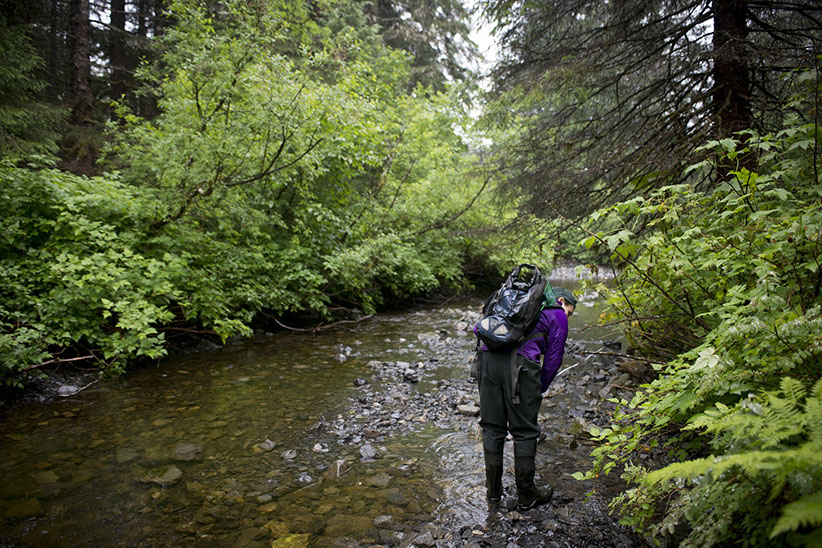
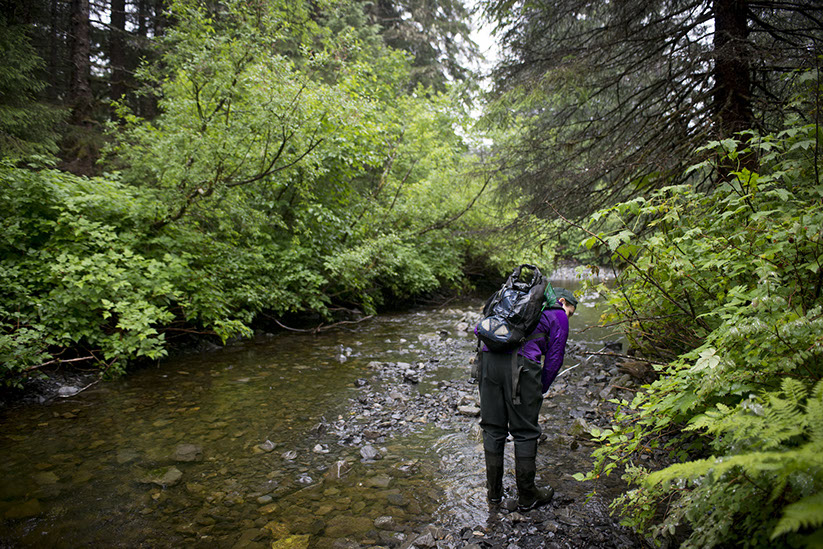
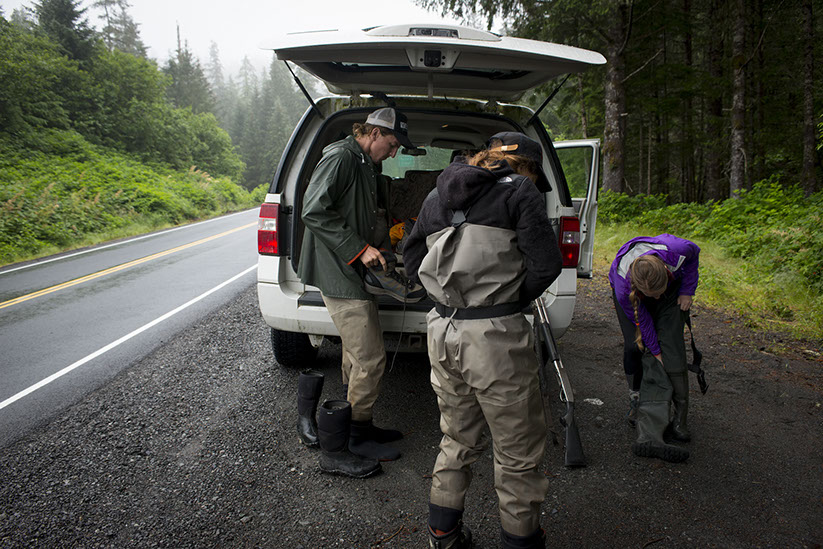
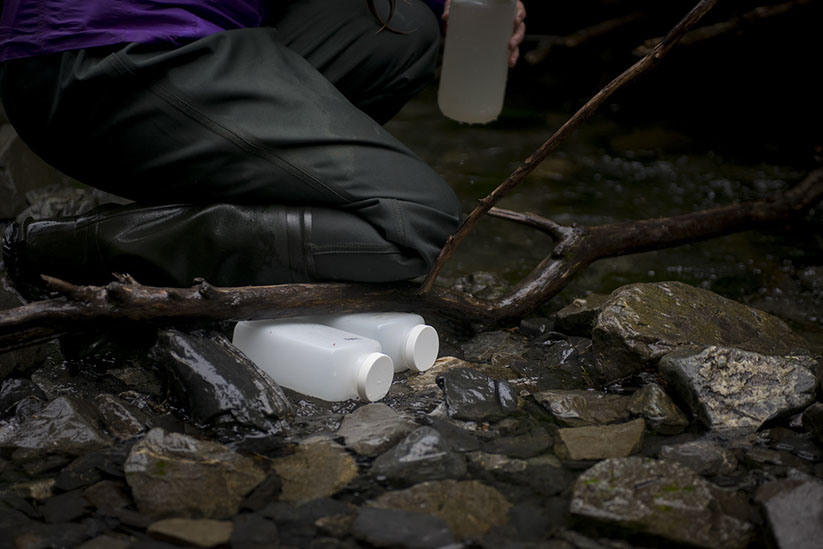


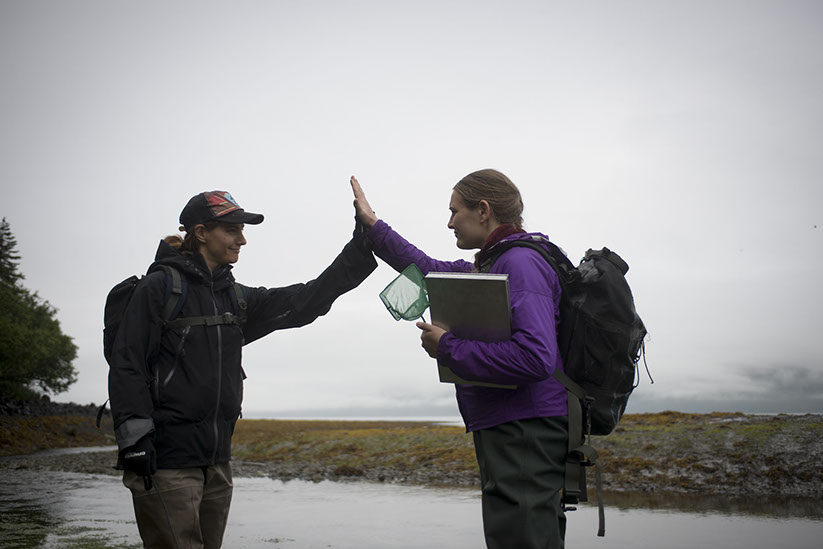
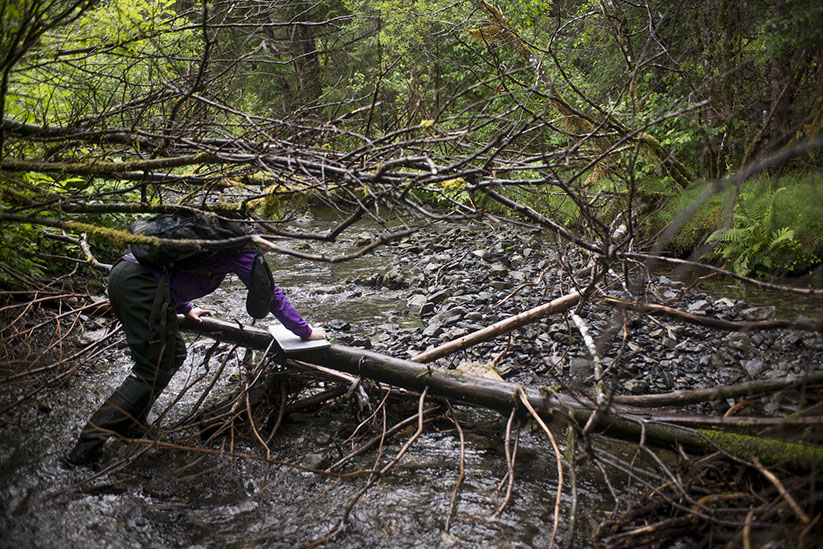
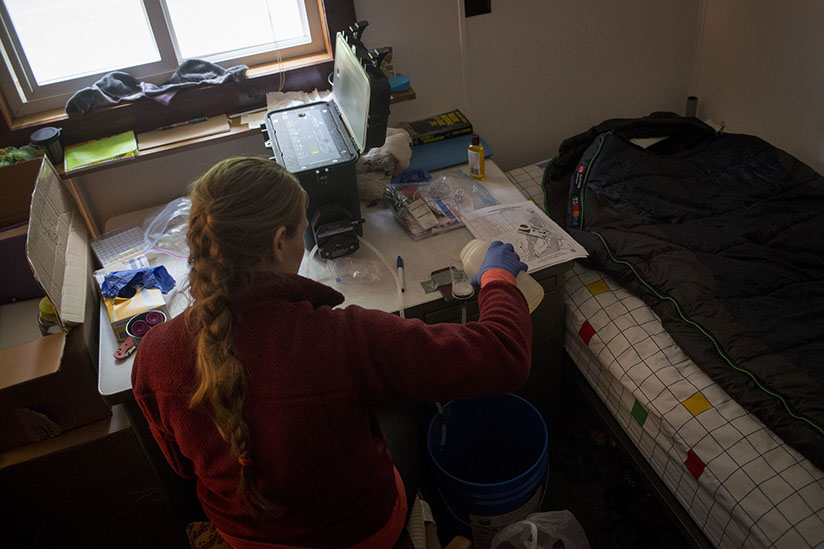
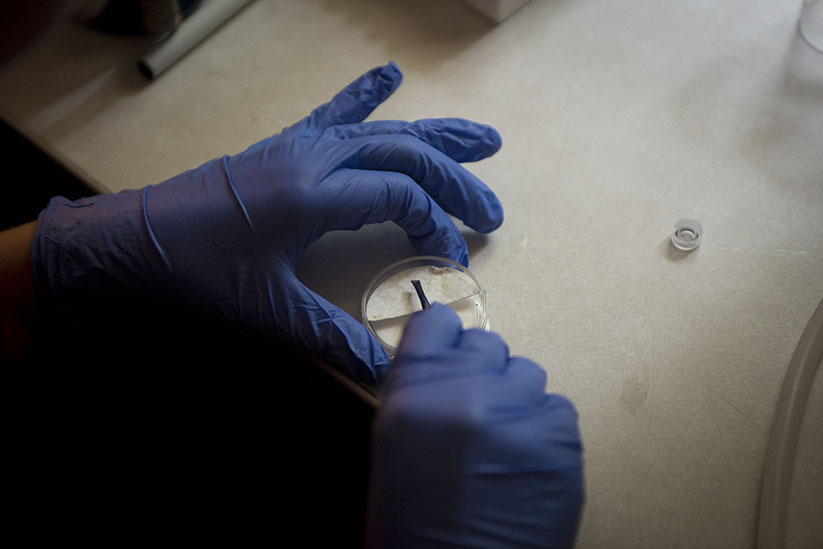



Carmen Harjoe peers into brush along Eccles Creek in search of toads. She and her assistant, Jules Cooch, came to Cordova, Alaska to do research on amphibians, which appear to be declining. Since there has been virtually no research on amphibians of the Chugach Area in the past, however, they are unable to determine any trends in the population numbers. “Alaska Fish and Game and the Forest Service were really interested in looking at the status of their toads, and they have a few historic observations of toads. What I’m basically doing is rechecking to see if they are still there,” says Carmen. “That can kind of give us an idea of what’s going on with these kinds of populations, since most of what we’ve heard is purely anecdotal.” Carmen and Jules began their scientific inquiry in response to the stories about toads they’ve heard from Cordova locals.
Dan Jenkins (left), Jules Cooch (center), and Carmen Harjoe put on waders in preparation for their trek down Eccles Creek near Cordova, Alaska. "It's just stunning." Jules says of the area, "If you like to travel, science can be a really cool career, because you get to go to a lot of remote places."
Carmen Harjoe stops at the end of a 100-meter transect in Eccles Creek near Cordova, Alaska to collect water samples. She’ll filter these at the U.S. Forest Service bunkhouse, where she, Dan, and Jules are staying, then bring the filters back to Oregon to run EDNA tests, which can show if amphibians have passed through that water within two weeks of the water collection.
Carmen Harjoe pulls a 100-meter measuring tape downstream to set up water samples of Eccles Creek. As an undergraduate at University of Missouri, Harjoe focused on ornithology, the study of birds. Then she took an opportunity to do basic research on amphibians. “I was fascinated by the places we were going to collect animals and study their behavior,” she says. Now she’s getting a doctoral degree focusing on diseases and pathogens in amphibians. “It’s funny how things you expect to do, they don’t really pan out…I should be an ornithologist!”
Near the end of Eccles Creek, where it runs into the ocean, grassy wetlands replace dense forests. Dan Jenkins, a biological technician for the Cordova Ranger District and self-proclaimed “gun slinger” walks alongside the creek, keeping watch for bears. “I get tossed around on various projects.” He says of his work. “It’s more or less a novel experience each time, which is what I really enjoy about it.” And as for the day-to-day parts of his job? “It’s wet,” he says.
Jules Cooch (left) and Carmen Harjoe enjoy a short celebration when they reach the end of Eccles Creek. They found no toads today, but still have the water samples to analyze when head back to Oregon State University. Their spirits are untainted, “I’ve never walked a creek straight into the ocean before,” says Harjoe excitedly, “That was frickin’ cool!”
Wading through Eccles Creek is not as easy as it may sound. Carmen Harjoe crawls over fallen debris on her way back to the car. “That’s field work,” she says, “It’s full of lovely surprises.”
Back at the Forest Service bunkhouse, Carmen Harjoe brings water samples to the “bedroom lab,” a pump and sample-processing system she and Jules have set up on the table between their two beds.
Carmen Harjoe prepares water samples that she will ship back to Oregon State University to be analyzed for remnant amphibian DNA. “These are my filters. So some of these are .45 microns, which is unbelievably small, and also .22 microns, which is even more unbelievably small.” Pumping the water through these filters takes about half an hour per sample. Preparing the nine samples she collected today from Eccles Creek will take hours.
Carmen Harjoe displays the finished product of the water samples she collected today at Eccles Creek. After pumping a liter of water through the fine mesh of the filters, she folds them so they fit into tiny tubes. These will then be sent back to Oregon State University, where she’ll analyze them for remnant amphibian DNA, or in her own words: “crush the crap out of [the filters] and do a DNA extraction…Then I'll be able to tell what was in the water when I took the sample.” This process can tell her whether or not toads have been around the area within the past two weeks. “That's so crazy that you can do that.” She says.
Marv Van Den Broek has lived in Cordova with his wife, Mazie for more than four decades. When his kids were young, they would go to ponds to collect and play with tadpoles. “There were hundreds; it would be black, and we brought some home and kept them in a little aquarium,” he remembers. “Since then, my last sighting was 8 years apart. I don’t know where they went. How could they go from hundreds to this very limited thing? We're lucky to see one now. Very lucky.” Until Carmen Harjoe’s research is published, anecdotal evidence like Marv and Mazie’s is all the Forest Service has as a reference for toad populations.
Mazie Van Den Broek lives with her husband, Marv, in their log house in Cordova. “One of the other reasons that I really enjoy living here is that there's a direct contact between our lives and how we provide for our lives…I make a lot of the things that we eat and a lot of the things that we wear…[There’s] a very good connection between our lives and our environment.” She and Marv were among the first to notice that toads seemed to be disappearing around Cordova.
1 - 12
<
>



by Maria Kjellstrand
There used to be toads around Cordova, Alaska.
I heard the story from Marv and Mazie Van Den Broek, who remember when tadpoles filled the pond near their log cabin in Cordova. “When our kids were little, which would have been 25 years ago,” remembers Mazie, “there were thousands.” Marv spotted a toad a few weeks ago, but it’s the first he’s seen in eight years.
Jack Stevenson, longtime Cordova resident, remembers catching toads after school in the pond next door to Cordova’s elementary school. That was about forty years ago. Now he, too, notices that the toads are gone.
At some point, scientists started paying attention to this accumulation of memories –all with the same punchline: The toads are going away. And that raised the obvious next question: Why?
Toads may not elicit the same awe as Alaska’s moose, eagles, or bears, but in ecological terms, it’s just as important to pay attention to the little guys. With permeable skin and life cycles that bring them through both aquatic and terrestrial ecosystems, toads and other amphibians respond strongly to environmental change—rough-skinned canaries in the coalmine, if you will.
Plus, the stories of toads around Cordova sound alarmingly similar to the story of amphibians in the lower 48, and, in fact, the rest of the world. Amphibians, which have been around since before dinosaurs, have seen 163 species go extinct just in the past twenty years. That’s about 45,000 times higher than the background extinction rate (the “normal” rate of extinction for the amphibian group). Amphibians currently hold the dubious title of the most endangered group of fauna in the world. Elizabeth Kolbert, author of The Sixth Extinction, calls the recent global decline of amphibians the beginning of a mass extinction event we as humans have never experienced before.
Which is why the U.S. Forest Service in Cordova started asking about the science behind the locals’ anecdotes. Enter Carmen Harjoe, a doctoral student in Integrative Biology at Oregon State University, invited to come to Cordova for several weeks in July and August to study the distribution of Boreal Toads and Wood Frogs—the region’s only two amphibian species, often treated as one due to their shared habitat and pathogen susceptibilities. Carmen and her assistant, Jules Cooch, headed into the field to visit sites in the Chugach area—a mountainous coastal region of Southeastern Alaska covering parts of the Prince William Sound, Copper River Delta, and Kenai Peninsula—where the amphibians have historically been spotted. “That can give us an idea of what’s going on with these kinds of populations, since most of what we’ve heard is purely anecdotal.” They want numbers, tangible evidence, to back up, or refute, the stories they hear.
So we ventured to Eccles Creek in the Copper River Delta, in search of toads.
This is not Carmen’s first time around the search-for-amphibians-in-wet-places block. She met Jules in Costa Rica while doing a study on Strawberry Poison Dart Frogs, and holds a particular affection for amphibians. “Waders are like a second home,” Carmen says as she clips the buckles and ties her boots. Dan Jenkins, a biological technician joining the two researchers, prepares his bear gun for the field, sliding 12-guage slugs into the magazine of a pump shotgun. A steady drizzle patters through the dense brush on either side of the creek.
“And away we go!” exclaims Jules, and so we do.
The creek winds through a murky forest, gurgling over shallow rocks and fallen trees. Jules holds one end of a 100-meter measuring tape while Carmen holds the other, hiking downstream with the rest of us. The two researchers peer into eddies and around the shoreline for toads, wading slowly through the creek. An image of Marv and Mazie’s kids comes to mind, I see them poking through the undergrowth for a new, web-toed pet, and I imagine them finding one. I ask Carmen what happens if we do.
“There’s a pretty hefty reward for finding an adult,” says Carmen. Jules and Dan nod in agreement.
“A reward?” I ask.
“Beer,” she says, laughing, “very scientific motivation.”
But amid the joking, they know what they’d do.
“First we take a swab for amphibian chytrid fungus, and then I do another non-lethal method to test for ranavirus.” Explains Carmen. They want to find out if the amphibians here are infected with two pathogens that have contributed to massive amphibian declines in other areas.
We hope not. The presence of amphibian chytrid fungus would be a troubling diagnosis for the frogs and toads in this region. The pathogen closes off amphibians’ ability to absorb electrolytes through their skin, effectively causing them to have a heart attack. Finding evidence of the pathogens “is not necessarily a death sentence,” says Carmen, but on top of habitat loss, encroaching contaminants, and a growing pet trade, it is one more stress that these toads don’t need.
Marv and Mazie are baffled by the notion of environmental toxins like chytrid fungi near Cordova, a town in the middle of what seems like pristine wilderness by any measure. “It’s basically untouched,” says Marv. When he looks out the window of his cabin at the edge of Cordova, he sees a forest that looks much as it did when he moved there over four decades ago. But underneath the seemingly unchanging surface could be lurking profound shifts to this ecosystem.
Carmen’s muffled “Stop!” comes from upstream. We’ve reached the end of the first 100 meter transect. A few minutes later, Jules catches up, rolling up the measuring tape as she sloshes along. Carmen is already busy filling three Nalgene bottles from the creek to take back and sample later for DNA.
Jules and Carmen perform three of these transects for each study site. This is their third day out and so far, they’ve only found one lonely tadpole. When we reach the end of the stream (the absolute end—the creek runs straight into the ocean), we’ve seen nothing but a group of minnows and a few frog-shaped leaves.
But the biologists remain hopeful. “This is kind of what I expected…with smaller, patchier populations, we’re probably not going to find them. But this survey method is kind of tried and true for finding them if they’re there.” Plus, there are still the water samples to analyze. So, after stripping off damp waders and a hefty sip from a (non-sample) Nalgene, we head back to U.S. Forest Service gear room, bunkhouse and field lab at the edge of Cordova.
Here, Carmen and Jules have set up what they call the “bedroom laboratory” – a pump, a bucket, a set of microcentrifuge tubes and various small instruments and tools – all on a small desk between their two beds.
Carmen puts all but one of the samples in their kitchen fridge for the time being. (“Normal people would have a sample fridge but…why not have it on top of the pasta salad?”) She brings one of the bottles back to their bedroom. With a robotic whirring sound, Carmen switches on an electric pump, pushing the sampled water through extremely fine filters. The filters end up in tiny plastic tubes, ready for analysis when Carmen returns to Oregon State University and a lab slightly more sophisticated than the one in her bunkroom. The process takes about half an hour per sample. She has nine to run tonight before heading to bed.
By analyzing the water samples, Carmen can “go back in time.” Remnant amphibian DNA can be detected from up to two weeks prior to today’s survey. If we missed a frog or toad, the water samples can still tell us if they’ve been around, “which is super cool,” Carmen concludes.
She’ll have the water samples analyzed by the end of this winter, but as far as the visual study, by the time she leaves Alaska in mid-August, Carmen found toads at fewer than half of previously occupied sites. “Part of the problem with amphibian monitoring,” she says, “is we hardly ever have long term data.” It’s hard to extract trends about a population. “You know, wolves have collars and everything, we know pretty well what’s happening to them but toads…they’re not charismatic megafauna.”
But despite lacking the fluffy Alaskan charm of a wolf, these toads serve as an important indicator of change. Biodiversity loss, climate change, the spread of pathogens…“they’re all linked,” says Carmen. This study, like most, is just one piece of the broader picture.
What we do know is that climate change significantly affects precipitation and temperature – both crucial factors in amphibians’ wellbeing. And for that matter, the wellbeing of both the pathogens that kill them and the ecosystem that supports them. A dynamic ecological interplay – one that, of course, we are a part of as well.
And biodiversity loss is as much an ecological injury as it is a loss of identity. Especially for a town like Cordova, centered around natural resources and surrounded by wilderness. Helen McDonald writes in a recent article that “Increasingly, knowing your surroundings, recognizing the species of animals and plants around you, means opening yourself to constant grief.”
The story of amphibians in Alaska hasn’t met a tragic ending yet, but it is a reminder to pay attention to the microfauna, charismatic or not. Because their story here might give us early clues to a larger story of global declines – mass extinction – and changes to what we thought was a pristine ecosystem.
For now we’ll remember Marv and Mazie’s kids chasing toads in a nearby stream and notice the silent evenings that used to be filled with the rhythmic chirps of frogs.
Change finds its way – even in this little one-road town in wild Alaska


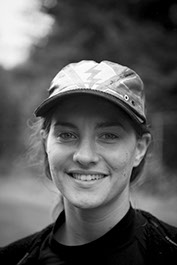
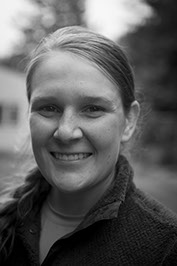

Marv, Cordova Resident
Mazie, Cordova Resident
Jules Cooch, Oregon State University Field Researcher
Carmen Harjoe, Oregon State University Field Researcher
Dan Jenkins, Biological technician for the Cordova Ranger District